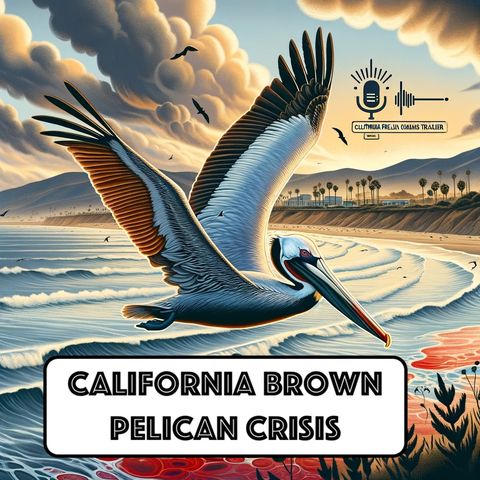
Contatti
Info
California's pelicans, with their majestic wingspans and signature plunge-diving technique, are facing a critical challenge. Since April 2024, wildlife rehabilitation centers across the state have reported a surge of emaciated,...
mostra di piùThe pelicans arriving at rehabilitation centers paint a grim picture. Many are skeletal, with weak muscles and sunken eyes, a testament to prolonged starvation. Others suffer from injuries, including broken wings and entanglement in fishing gear. These secondary complications likely stem from the birds' weakened state, making them more susceptible to accidents and predation.
The exact cause of the crisis remains under investigation. However, several theories are being explored:
Food Scarcity: A lack of readily available fish, the pelican's primary food source, is a prime suspect. This scarcity could be due to overfishing, changes in ocean currents impacting prey distribution, or algal blooms affecting the marine ecosystem.
Habitat Degradation: Pollution, coastal development, and climate change can all disrupt the delicate balance of the pelican's habitat, making it harder for them to find food and nesting sites.
Disease Outbreak: While no specific disease has been confirmed, wildlife officials are not ruling out the possibility of a contagious illness contributing to the pelican's decline.
The situation has galvanized wildlife rehabilitation centers across California. Veterinarians and wildlife rehabilitators are working tirelessly to provide treatment and care for the affected pelicans. This includes rehydration, nutritional support, and treatment for injuries. However, these centers are facing a growing number of patients, straining their resources.
The California Department of Fish and Wildlife (CDFW) is at the forefront of the response effort. Scientists are conducting necropsies on deceased pelicans to determine the cause of death. Additionally, collaboration with fishermen and researchers is underway to gain a better understanding of potential food source limitations. Public awareness campaigns are also being launched to encourage donations to support wildlife rehabilitation centers and promote responsible fishing practices.
The California Brown Pelican Crisis of 2024 highlights the interconnectedness of our environment. The health of these pelicans is a barometer for the health of the California coast. While the immediate focus is on saving the pelicans currently in distress, long-term solutions require addressing the underlying issues, such as habitat conservation, sustainable fishing practices, and combating climate change.
The outcome of this crisis remains uncertain. However, the dedication of wildlife professionals, researchers, and the public offers a glimmer of hope. By working together, we can ensure that these magnificent birds continue to grace the California coastline for generations to come.

California's pelicans, with their majestic wingspans and signature plunge-diving technique, are facing a critical challenge. Since April 2024, wildlife rehabilitation centers across the state have reported a surge of emaciated,...
mostra di piùThe pelicans arriving at rehabilitation centers paint a grim picture. Many are skeletal, with weak muscles and sunken eyes, a testament to prolonged starvation. Others suffer from injuries, including broken wings and entanglement in fishing gear. These secondary complications likely stem from the birds' weakened state, making them more susceptible to accidents and predation.
The exact cause of the crisis remains under investigation. However, several theories are being explored:
Food Scarcity: A lack of readily available fish, the pelican's primary food source, is a prime suspect. This scarcity could be due to overfishing, changes in ocean currents impacting prey distribution, or algal blooms affecting the marine ecosystem.
Habitat Degradation: Pollution, coastal development, and climate change can all disrupt the delicate balance of the pelican's habitat, making it harder for them to find food and nesting sites.
Disease Outbreak: While no specific disease has been confirmed, wildlife officials are not ruling out the possibility of a contagious illness contributing to the pelican's decline.
The situation has galvanized wildlife rehabilitation centers across California. Veterinarians and wildlife rehabilitators are working tirelessly to provide treatment and care for the affected pelicans. This includes rehydration, nutritional support, and treatment for injuries. However, these centers are facing a growing number of patients, straining their resources.
The California Department of Fish and Wildlife (CDFW) is at the forefront of the response effort. Scientists are conducting necropsies on deceased pelicans to determine the cause of death. Additionally, collaboration with fishermen and researchers is underway to gain a better understanding of potential food source limitations. Public awareness campaigns are also being launched to encourage donations to support wildlife rehabilitation centers and promote responsible fishing practices.
The California Brown Pelican Crisis of 2024 highlights the interconnectedness of our environment. The health of these pelicans is a barometer for the health of the California coast. While the immediate focus is on saving the pelicans currently in distress, long-term solutions require addressing the underlying issues, such as habitat conservation, sustainable fishing practices, and combating climate change.
The outcome of this crisis remains uncertain. However, the dedication of wildlife professionals, researchers, and the public offers a glimmer of hope. By working together, we can ensure that these magnificent birds continue to grace the California coastline for generations to come.
Informazioni
| Autore | QP-3 |
| Organizzazione | William Corbin |
| Categorie | News |
| Sito | - |
| corboo@mac.com |
Copyright 2024 - Spreaker Inc. an iHeartMedia Company
